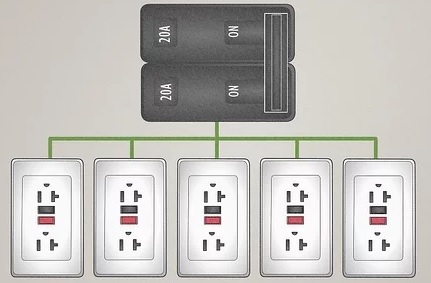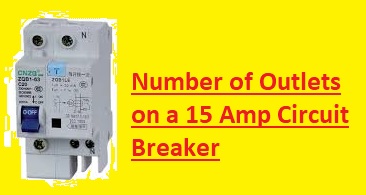Hello readers welcome to the new post. In this post, we will have a look at How Many Outlets on a 15 Amp Circuit Breaker? Our electrical systems are based on circuit breakers to protect us from possible bad effects produced by overloads and short circuits. Every circuit breaker has an ampere (amp) rating that defines how much electrical current it can safely handle. Knowing a circuit breaker’s capacity is the main factor, especially when it considers the number of outlets it can handle. In this post, we’ll cover the question of how many outlets can be connected to a 15-amp circuit breaker and explain you best tips to make sure your electrical system is both safe and effective. Let’s get started with how many outlets on a 15-amp circuit
Introduction
It’s important to understand the basis of circuit breakers and their ampere values before getting more details. When current cross limits break works as a safety device and controls current to flow. Through this process possible fire hazards, appliance damage, and electrical system damage are all avoided. The maximum current that a circuit breaker can handle without tripping is determined by the ampere rating, called the amp rating.
What is Circuit Breakers
it is the main component of electrical power systems known as circuit breakers. They operate as safety walls between current and different outlets and devices in the circuit and it is exist in electrical panels or breaker boxes. A circuit breaker stops the flow of current when it detects an overload or a short circuit,
Role of Amps in Circuit Breakers
Electric current flow through the circuit is measured in units called amperes. The highest current that a circuit breaker can handle without tripping is measured in an ampere rating. For the secure operation of the system, it is needed to define the connection between amps and circuit breakers.
read also Which AWG is Best for 60 Amp Breaker
What Is a 15 Amp Circuit Breaker?
The common type of circuit breaker that is used in both residential and commercial structures is the 15-amp circuit breaker. It can have a continuous current flow of up to 15 amps due to its maximum ampere rating of 15 amps. it is a good rating for general-purpose circuits that use current tot operate low-power devices like lighting fixtures and small power appliances.
Number of Outlets on a 15 Amp Circuit Breaker
Different parameters are considered for determining how many outlets can be securely connected to a 15-amp circuit breaker. Although there are no fixed rules, differnt principles can help in decision-making.
Factors to Consider
- Outlet Load: There is certain value of load that each outlet can handle. The overall load of the circuit can be handled by adding individual loads of every outlet on it.
- Circuit Length: The electrical resistance of a circuit is affected by its overall length, as well as the wire. High resistance is commonly used in longer circuits, which can cause voltage loss and related possible issues
- Appliance Usage: It is necessary to understand the power use of appliances that will be connected to the circuit. Devices with larger power requirements, like refrigerators, and air conditioners, are considered individually.
related: What Size Wire for 100 Amp Service
Types of Outlets and Their Amp Requirements
- Standard Outlets: It is used in homes due to fifteen ampers ratings
- GFCI Outlets: Ground Fault Circuit Interrupter outlets, connected in bathrooms, kitchens, and outdoor places, are 15 amps rating
- Dedicated Outlets: As they suggest used to power certain appliances and can have different amp ratings. Such as outlets for air conditioners or refrigerators need 20 amps.
Can I have 10 outlets on 15 amp circuit?
You can connect as many outlets as you want on a 15 amp circuit break. But the basic rule is that there must be 1 outlet per 1.5 ampers, which is about eighty percent of the capacity of the breaker. So we will suggest connecting 8 outlets for 15 amp circuit
How many outlets can be on a 15-amp circuit in Canada?
The maximum number of outlets that can be connected to a 15 amp circuit in Canada is according to rules as in the US. The number of outlets that can be attached to a 15 amp circuit is not strictly regulated by the National Electrical Code of Canada. For residential applications, it is suggested to follow the rule of no more than 10 outlets on a 15-amp circuit. This keeps the electrical system safe by confirming that the load on the circuit is not larger than its amp rating.
What is the maximum load on a 15 amp breaker?
A 15-amp circuit breaker can handle 1800 watts load. However the permissible maximum load for a 15-amp circuit breaker is 1440 watts.
Is it 15 amps per outlet?
No, every outlet need not have 15 amps. The maximum load that an outlet can handle is often indicated by the amp rating of the outlet. Standard outlets in North America are rated for 15 amps. This doesn’t show that every outlet should or will constantly draw 15 amps; it only defies that the outlet itself can handle a load of up to 15 amps. The appliances and devices plugged into each outlet find their load.
How many amps does a fridge use?
Based on the size, brand, and efficiency of the device, a refrigerator’s amp use can be different. A normal family refrigerator may be between 3 and 6 amps and can move to 15 amps. However, it’s important to review the accurate details of your refrigerator since the amp use can change.
How many amps does a TV use?
The size and type of a TV can also affect how many amps it uses. The majority of modern LED or LCD TVs have relatively lower power requirements. A regular TV can use between 1 and 2 amps, while larger or more power-hungry TVs can need more power. For an accurate amp rating, it is suggested to refer to the manufacturer’s features on the TV’s label.
What voltage is 15 amps?
Normally TV uses fifty to two hundred watts, according to the model. Normally TVs use less than 1 amp and connect to a 120-volt outlet.
What appliances require 20 amps?
In General, 20 amp circuits are used to connect different appliances and devices that need a high amp rating. The following are some examples of appliances that use 20 amps:
- Large power tools or equipment
- Electric water heaters
- Air conditioners
- Electric ranges or ovens
- Clothes dryers
- Electric vehicle charging stations
How Many Outlets Are in Most Bedrooms?
The number of outlets in bedrooms can change based on differnt variables, like the local construction rules, the room’s size, and the homeowner’s certain electrical needs. However, when it comes to the number of outlets in most bedrooms, certain criteria are frequently observed.
The 12-foot wall in the room has one outlet at least on each wall.
How Many Lights Can I Plug in a 15-Amp Circuit?
Depending on the wattage of the lights, a 15-amp circuit can handle a certain number of plugs. must find the overall wattage and ensure that it does not larger the circuit’s capacity to establish the maximum number of lights.
A 15-amp circuit operating at 120 volts in the USA can deliver up to 1,800 watts (15 amps x 120 volts). Divide the combined wattage of the lights by the wattage per light to get to know how many lights you can plug in.
define out how many lights there are if every light bulb uses 60 watts, for example, 1,800 watts / 60 watts per light = 30 lights.
This assumes that there are no other electrical outlets or devices configured to the circuitry than the lights. To avoid overloading the circuit, it’s important to consider the wattage of other devices on it.
How Many Outlets On A 20 Amp Circuit?
The 20 amp circuit comes with the highest of 16 ampere current to draw, such as a total watt of 1,920W at 120V. Here outlet connected to 20 amp circuit is shown.
| Device Amp uses | Amps | Wattage Per Device for (120V) |
| 1 Amp | 16 Outlets | 120 Watts |
| 1.5 Amps | 11 Outlets | 180 Watts |
| 1.6 Amps | 10 Outlets | 192 Watts |
| 2 Amps | 8 Outlets | 240 Watts |
| 4 Amps | 4 Outlets | 480 Watts |
| 8 Amps | 2 Outlets | 960 Watts |
| 16 Amps | 1 Outlet | 1,920 Watts |
Can I Connect a 20-Amp Receptacle With a 15-Amp Circuit?
No, it is not suggested to connect a 20-amp outlet to a circuit rated for 15-amps. To maintain compatibility and avoid any electrical risks, the amp rating of the receptacle should be according to the amp rating of the circuit.
A 20-amp outlet is created to securely carry a larger electrical load than a 15-amp circuit can. A 20-amp outlet being configured to a 15-amp circuit can overload the circuit, cause it to overheat, damage the wiring or other devices, or also start a fire.
To ensure electrical safety and compliance with electrical rules, receptacles must always be used that correspond to the circuit’s amp rating.
How Many Outlets on a 15 Amp Circuit Breaker?
Each circuit comes with some restrictions, the basic parameters for circuit load must not be higher thatn the predefined current limit. For 15 amper circuits, it is suggested not to cross the limit of 15 amperes. it is 80 percent rule used for circuits without following breaker limitations.
The 80 percent rule defines that each circuit can work without no damage if it is used in well well-configured layout up to an 80 percent limit. Such as 80 percent limited of 15 amp circuit breaker is 12 amper. Since the current flow is not higher than 12 amperes, we can connect the outlet without any effect. it is suggested that a 15 amp circuit has an outlet about 8.
What Type of Outlet is used in a 15 Amp Circuit?
Two main parameters help to select accurate outlets that are featues and wiring needs. The wiring requirements is important for circuit creation. Also, minor errors in selecting of wrong wire can affect the operation of the circuit and it can damage permanently. 14 gauge wire used for 15 amp circuit with protection of 15 amp circuit breaker.
Can I Change a 15-Amp Circuit to a 20-Amp Circuit?
To transform a 15-amp circuit to a 20-amp circuit, larger than the circuit breaker has to be varied. It needs a review of the wiring, outlets, load estimates, also the overall electrical system.
The wiring and other components should be able to handle the higher electrical load to upgrade a circuit to 20 amps. If the current wire is not rated for 20 amps, it should be replaced with the wiring of the accurate gauge.
It’s important to note that any electrical work should always be done by a qualified electrician who can evaluate your certain situation, ensure compliance with local codes, and implement any needed electrical system repairs or improvements.
How Many Outlets Can You Put On One Circuit?
Local electrical codes, the circuit’s amp rating, and the power demands of the connected devices are some factors that affect how many outlets you may add to a circuit.
The National Electrical Code recommends a maximum of 10 outlets on a 15-amp circuit for residential applications as a general rule. However, it’s important to consider the circuit’s overall load and ensure it does not exceed the amp rating.
The number of outlets that can be safely installed on one circuit can vary based on factors like the wattage of the devices, the length of the circuit, and the certain needs of your electrical system.
How to Check if Your Circuit Is 15 or 20-Amp?
To determine whether a circuit is 15 or 20 amps, follow these steps
- Find the home’s circuit breaker panel. It is generally installed in a garage, basement, or utility room.
- To examine a certain circuit, locate the circuit breaker that connected to it
- Check the circuit breaker’s labeling. The amp rating is often indicated, and it can be written on the switch or just next to it.
- It is a 15-amp circuit if the circuit breaker is labeled with that ampacity value. It is a 20-amp circuit if the label says it is.
How Many Outlets Can You Put On a 15-Amp Circuit?
According to the NEC code, it is suggested to connect 12 outlets on one circuit of 15 amperes, the latest outlets needed an arc fault and some electricians did not connect them with light fixtures. Breaker Sense arc in circuitry if we unplug any device and an electric arc is created, it will trip the breaker, minimizing the chances of electrical hazard.
What is the Reason I Need to Limit the Number of Outlets on a Circuit Breaker?
To avoid overloading the circuit and maintain electrical safety, the number of outlets on a circuit breaker should be limited. The amp rating of every circuit breaker explains how much electrical current it can handle
Overheating from exceeding a circuit breaker’s amp rating can result in the insulation on wires melting or igniting. With that, it can damage electrical equipment and increase electrical shock risk
The complete electrical need is spread more equally by restricting the number of outlets on a circuit breaker. This ensures that every outlet has a safe and dependable source of electricity and prevents the circuit from getting overloaded.
When choosing the number of outlets on a circuit, it’s important to follow electrical laws and regulations to preserve electrical safety and avoid any risks.
Read Also:
- HOW MANY AMPS CAN 2 AWG WIRE HANDLE?
- How Many Receptacles on a 20 amp circuit
- What Gauge Wire for 30 AMP 220v
- What Size Wire for 200 AMP Service Underground
- Key Knowledge of AAA Battery Voltage, Capacity, Size & Dimensions
- Difference Between a Single and Double Pole Breaker
- What is circuit breaker | Working Principle & Why Is It Important?
Faqs
Can I have 10 outlets on 15 amp circuit?
We can run any number of outlets with 15 amper circuit theoretically, but practically it is limited. 15 amp circuit every outlet uses 1.5 amperes tha is 10 outlet. The 80 percent rule defines only 80 percent of the circuit are outlets that is 8 outlets for a 15 amp circuit.
What is the capacity of a 15 amp breaker?
How many volts is a 15 amp breaker?
15-amp 120-volt circuit: 15 amps x 120 volts = 1,800 watt
How many amps for 10 outlets?
The best method is to suppose there is the highest power use of 1.5 ampers for a single outlet, helping 10 outlets for one 20amp circuit.
How many amps is one outlet?
What is a 15 amp breaker used for?
Small household devices such as blenders and microwave ovens. outlet such as kitchens or bathrooms where small devices might be used. Lighting circuits.











